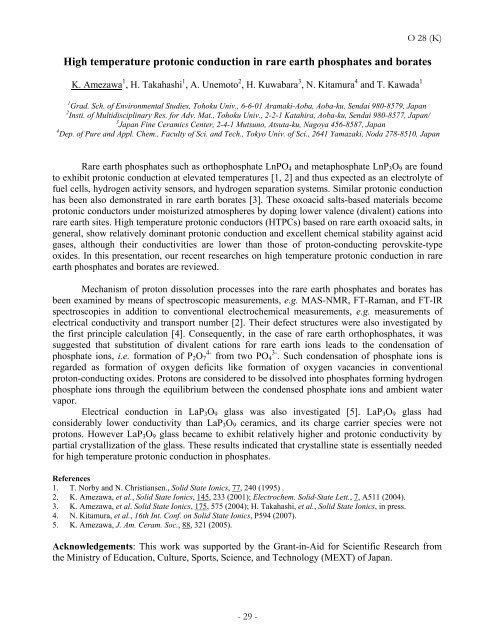Abstracts S S P - SSPC-15 - California Institute of Technology
Abstracts S S P - SSPC-15 - California Institute of Technology
Abstracts S S P - SSPC-15 - California Institute of Technology
You also want an ePaper? Increase the reach of your titles
YUMPU automatically turns print PDFs into web optimized ePapers that Google loves.
O 28 (K)<br />
High temperature protonic conduction in rare earth phosphates and borates<br />
K. Amezawa 1 , H. Takahashi 1 , A. Unemoto 2 , H. Kuwabara 3 , N. Kitamura 4 and T. Kawada 1<br />
1 Grad. Sch. <strong>of</strong> Environmental Studies, Tohoku Univ., 6-6-01 Aramaki-Aoba, Aoba-ku, Sendai 980-8579, Japan<br />
2 Insti. <strong>of</strong> Multidisciplinary Res. for Adv. Mat., Tohoku Univ., 2-2-1 Katahira, Aoba-ku, Sendai 980-8577, Japan/<br />
3 Japan Fine Ceramics Center, 2-4-1 Mutsuno, Atsuta-ku, Nagoya 456-8587, Japan<br />
4 Dep. <strong>of</strong> Pure and Appl. Chem., Faculty <strong>of</strong> Sci. and Tech., Tokyo Univ. <strong>of</strong> Sci., 2641 Yamazaki, Noda 278-8510, Japan<br />
Rare earth phosphates such as orthophosphate LnPO4 and metaphosphate LnP3O9 are found<br />
to exhibit protonic conduction at elevated temperatures [1, 2] and thus expected as an electrolyte <strong>of</strong><br />
fuel cells, hydrogen activity sensors, and hydrogen separation systems. Similar protonic conduction<br />
has been also demonstrated in rare earth borates [3]. These oxoacid salts-based materials become<br />
protonic conductors under moisturized atmospheres by doping lower valence (divalent) cations into<br />
rare earth sites. High temperature protonic conductors (HTPCs) based on rare earth oxoacid salts, in<br />
general, show relatively dominant protonic conduction and excellent chemical stability against acid<br />
gases, although their conductivities are lower than those <strong>of</strong> proton-conducting perovskite-type<br />
oxides. In this presentation, our recent researches on high temperature protonic conduction in rare<br />
earth phosphates and borates are reviewed.<br />
Mechanism <strong>of</strong> proton dissolution processes into the rare earth phosphates and borates has<br />
been examined by means <strong>of</strong> spectroscopic measurements, e.g. MAS-NMR, FT-Raman, and FT-IR<br />
spectroscopies in addition to conventional electrochemical measurements, e.g. measurements <strong>of</strong><br />
electrical conductivity and transport number [2]. Their defect structures were also investigated by<br />
the first principle calculation [4]. Consequently, in the case <strong>of</strong> rare earth orthophosphates, it was<br />
suggested that substitution <strong>of</strong> divalent cations for rare earth ions leads to the condensation <strong>of</strong><br />
phosphate ions, i.e. formation <strong>of</strong> P2O7 4- from two PO4 3- . Such condensation <strong>of</strong> phosphate ions is<br />
regarded as formation <strong>of</strong> oxygen deficits like formation <strong>of</strong> oxygen vacancies in conventional<br />
proton-conducting oxides. Protons are considered to be dissolved into phosphates forming hydrogen<br />
phosphate ions through the equilibrium between the condensed phosphate ions and ambient water<br />
vapor.<br />
Electrical conduction in LaP3O9 glass was also investigated [5]. LaP3O9 glass had<br />
considerably lower conductivity than LaP3O9 ceramics, and its charge carrier species were not<br />
protons. However LaP3O9 glass became to exhibit relatively higher and protonic conductivity by<br />
partial<br />
crystallization <strong>of</strong> the glass. These results indicated that crystalline state is essentially needed<br />
for<br />
high temperature protonic conduction in phosphates.<br />
References<br />
1. T. Norby and N. Christiansen., Solid State Ionics, 77, 240 (1995) .<br />
2. K. Amezawa, et al., Solid State Ionics, 145, 233 (2001); Electrochem. Solid-State Lett., 7, A511 (2004).<br />
3. K. Amezawa, et al. Solid State Ionics, 175, 575 (2004); H. Takahashi, et al., Solid State Ionics, in press.<br />
4. N. Kitamura, et al., 16th Int. Conf. on Solid State Ionics, P594 (2007).<br />
5. K. Amezawa, J. Am. Ceram. Soc., 88, 321 (2005).<br />
Acknowledgements: This work was supported by the Grant-in-Aid for Scientific Research from<br />
the Ministry <strong>of</strong> Education, Culture, Sports, Science, and <strong>Technology</strong> (MEXT) <strong>of</strong> Japan.<br />
- 29 -


